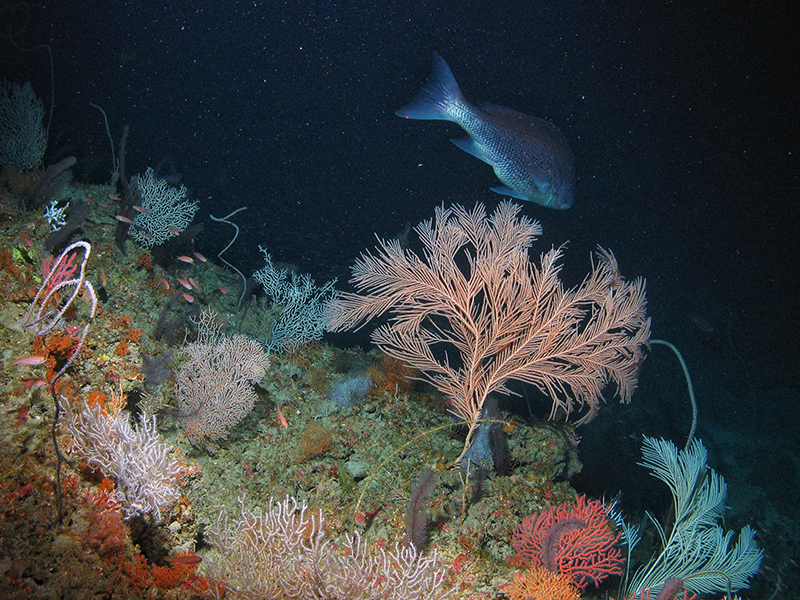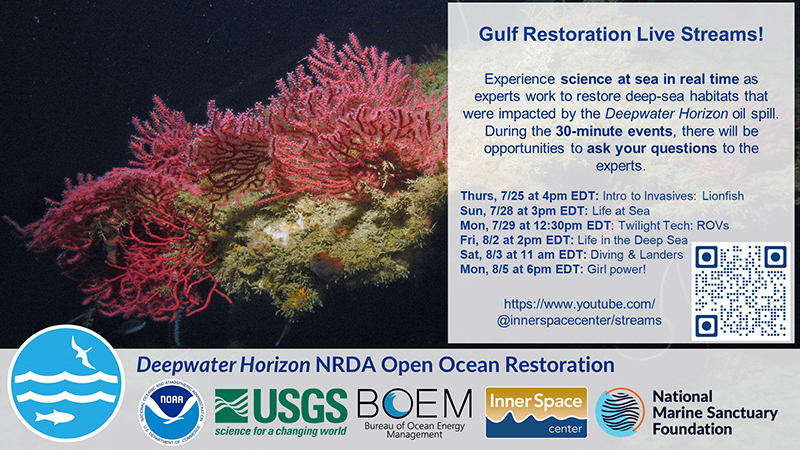UPDATE: New Livestreams — NOAA and Partners Lead Expedition to Advance Deep-Sea Habitat Restoration in the Gulf of Mexico
The upcoming expedition is part of a multi-year collaborative effort to restore deep-sea habitats in the Gulf of Mexico that were injured by the 2010 Deepwater Horizon oil spill, the largest offshore oil spill in U.S. history.
Throughout the expedition, public livestreams will offer an unprecedented opportunity to see restoration efforts in real time. These free programs will cover a range of topics, from invasive species, to ocean technologies, and life at sea. Livestreams and past recordings will be available on the University of Rhode Island's Inner Space Center’s Youtube page .
UPDATE: New livestreams in Fall 2024
- Thursday, October 3 at 10:30 a.m. CDT / 11:30 a.m. EDT: Life at Sea .
- Monday, October 7 at 1 p.m. CDT / 2 p.m. EDT: Remotely operated vehicles and Deep Sea Technology .
- Wednesday, October 9 at 2 p.m. CDT / 3 p.m. EDT: Coral Propagation .
Webinar dates and topics:
- Thursday, July 25 at 4 p.m. EDT: Introduction to Invasives: Lionfish .
- Sunday, July 28 at 3 p.m. EDT: Life at Sea .
- Monday, July 29 at 12:30 p.m. EDT: Twilight Tech: Remotely Operated Vehicles .
- Friday, August 2 at 2 p.m. EDT: Survival Mode: Life in the Deep Sea .
- Saturday, August 3 at 11 a.m. EDT: Twilight Tech: Diving and Landers .
- Monday, August 5 at 6 p.m. EDT: Girl power! .
Expedition background: Mesophotic and deep benthic habitats, or areas of the seafloor that see little to no sunlight, are home to a complex community of fish, corals, and other invertebrates. In the Gulf of Mexico, these habitats faced an unprecedented threat in 2010 when the Deepwater Horizon (DWH) oil spill released more than 134 million gallons of oil over an 87-day span. More than 770 square miles of deep-sea habitat were injured by the spill, an area about half the size of Rhode Island.
After the DWH oil spill, federal and state agencies formed the Deepwater Horizon Natural Resource Damage Assessment Trustee Council (DWH Trustees) to assess the impacts and identify actions to restore injured habitats, species, and the services they provide. From this assessment, they developed a comprehensive restoration plan to put the $8.8 billion in funds from the 2016 settlement with BP to work for the Gulf. One restoration type the DWH Trustees identified in the open ocean focuses on an important ecosystem along the seafloor: mesophotic and deep benthic communities. These long-term projects began in 2021 and focus on habitat assessment, seafloor mapping, deep-sea coral propagation, and active management of benthic habitats below 160 feet.

Mesophotic and deep benthic habitats are vast and complex ecosystems on the ocean floor that are a foundation of Gulf of Mexico food webs. Image courtesy of NOAA, Marine Applied Research & Exploration. Download largest version (3.33 MB).
This month, scientists, engineers, divers, and other collaborators embarked on the C-Innovation M/V Island Intervention, to continue to advance these restoration projects. The mission will use both a remotely operated vehicle and saturation divers from the Navy Experimental Diving Unit's Saturation Detachment to conduct surveys, collect coral and sediment samples, install mooring buoys to protect the seafloor in Flower Garden Banks National Marine Sanctuary, remove marine debris and other threats, and more. The expedition will be the first significant NOAA-Navy collaboration in the Gulf of Mexico, the deepest dive by humans for a NOAA science mission, and the first time a NOAA mission has used saturation diving.
Expedition partners include the U.S. Geological Survey, the U.S. Navy, Flower Garden Banks National Marine Sanctuary, the National Marine Sanctuary Foundation, Smithsonian's National Museum of Natural History, the University of Rhode Island, Audubon Aquarium, University of North Carolina Wilmington, and Mississippi State University.
Published July 23, 2024
Updated October 2, 2024
